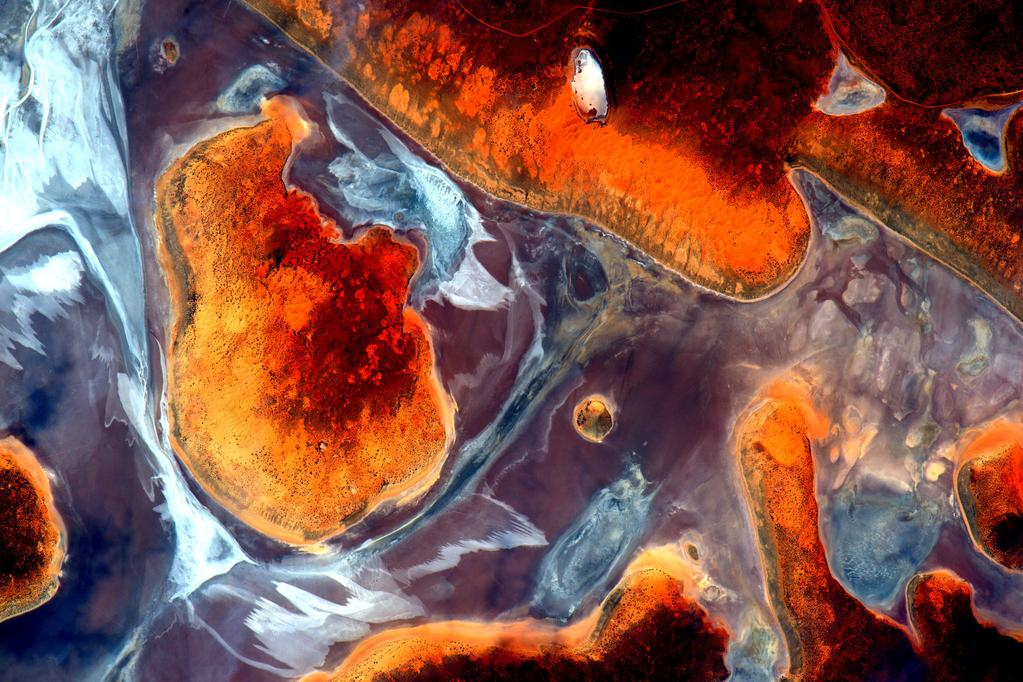
“#EarthArt The sun’s reflection appears to spill liquid metal onto this desert lake. #YearInSpace.”
Photo: Scott Kelly, courtesy NASA.
Photographer Scott Kelly, whose captivating shots of the earth reveal the wildly diverse beauty of our planet, has a unique vantage point from which to work: he’s also an astronaut, currently orbiting hundreds of miles above the earth.
Kelly is aboard the International Space Station (ISS) as part of the Year Long Mission, studying the effects of long-term spaceflight on the human body. (Kelly’s identical twin brother, Mark, a former astronaut, will be used as a baseline for comparison.)
“#EarthArt Our planet seems to have a sense of humor at times. #YearInSpace.”
Photo: Scott Kelly, courtesy NASA.
In addition to conducting important scientific experiments, Kelly is also adeptly photographing the dazzling views of the earth’s surface. Last week, Kelly’s Twitter followers—he has over 500,000—waited with baited breath as Kelly documented the ISS’s pass above Australia, sharing a remarkable range of terrain and topography in 17 dramatically different images.
Others have shared Kelly’s lofty perch, with fellow astronauts Reid Wiseman and Chris Hadfield also recently delighting Twitter users with their space photography. (Hadfield even published a book, You Are Here: Around the World in 92 Minutes.)
“#GoodMorning #Earth! You look quite peaceful this morning. #YearInSpace.”
Photo: Scott Kelly, courtesy NASA.
Kelly tends to favor more abstract imagery than his peers, however, capturing startling and unexpectedly colorful landscapes that seem utterly otherworldly. He has dubbed his colorful shots #EarthArt.
The ISS has also welcomed art from earth, with a meteorite sculpture by Katie Paterson becoming the first artwork on the space station this past summer. The piece was soon followed by a tiled mosaic from anonymous street artist Invader, featuring a character from the 1970s arcade game Space Invader. The first 3D printer used in space printed a 3D NASA logo on the ISS in November 2014.
“#EarthArt In 377 cumulative days in space, I’ve never seen this before today. #YearInSpace.”
Photo: Scott Kelly, courtesy NASA.
The Year Long Mission is a record-breaking one: on Friday, Kelly logged his 383rd career day in space, officially becoming the American astronaut to have spent the most cumulative days in orbit. Kelly is also on track to break the American record for the single-longest spaceflight on October 29, which will be the mission’s 216th day.
Kelly is scheduled to return to earth on March 3, 2016, following 342 consecutive days in space, for a total of 522 days over the course of his career.
“Woke up to the #Himalayas outside our window this morning. #GoodMorning and #HappyFriday! #YearInSpace.”
Photo: Scott Kelly, courtesy NASA.
“#NorthernLights mixed with the clouds below look rather imposing. #GoodMorning from @Space_Station! #YearInSpace.”
Photo: Scott Kelly, courtesy NASA.
“#EarthArt in one pass over the #Australian continent. Picture 1 of 17. #YearInSpace.”
Photo: Scott Kelly, courtesy NASA.
“#EarthArt in one pass over the #Australian continent. Picture 10 of 17. #YearInSpace.”
Photo: Scott Kelly, courtesy NASA.
“#EarthArt in one pass over the #Australian continent. Picture 6 of 17. #YearInSpace.”
Photo: Scott Kelly, courtesy NASA.